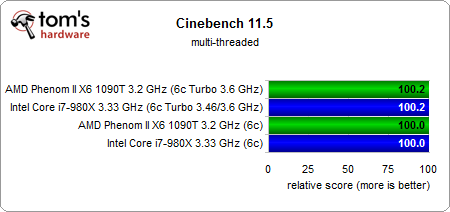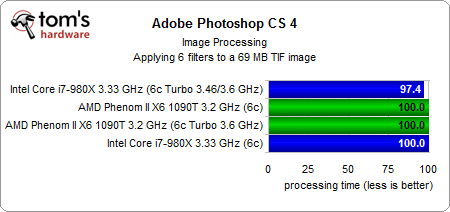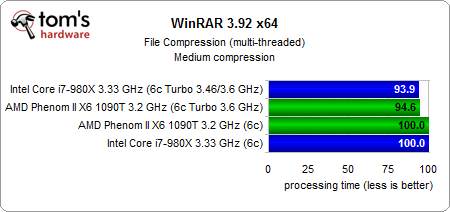CORE Or Boost? AMD's And Intel's Turbo Features Dissected
Intel arms its Core i5 and Core i7 CPUs with Turbo Boost. AMD's hexa-core Phenom II X6 chips sport Turbo CORE. Both technologies dynamically increase performance based on perceived workloads and available thermal headroom. Which one does the better job?
Benchmark Results: Applications
3ds Max is heavily threaded, and consequently doesn't benefit from accelerating clock speeds on single- or lightly-threaded loads.
7-Zip is thread-optimized, but it seems that this optimization is limited. Intel’s Turbo Boost shows a nice performance increase here, indicating that fewer cores with higher frequencies still yield big payoffs.
Cinebench in single-threaded mode runs faster on AMD's Turbo Core than on Intel’s Turbo Boost. This is because Intel allows only a 266 MHz increase, while AMD speeds up three cores by a more significant 400 MHz.
There are no differences once we switch to the multi-threaded workload.
The Fritz chess application benefits more from AMD’s Turbo CORE.
The same applies to PDF creation with Adobe Acrobat 9 from Microsoft PowerPoint. Since both applications cannot take advantage of multiple cores, AMD’s 400 MHz three-core acceleration has more effect.
Photoshop CS4 is very thread-intensive, but it seems that the +133 MHz boost by Intel’s Turbo feature still carries weight.
Get Tom's Hardware's best news and in-depth reviews, straight to your inbox.
WinRAR is thread-optimized and seems to benefit more from Turbo Boost than from Turbo CORE. However, both implementations see noticeable gains.
WinZip runs faster on the AMD platform, thanks to the 400 MHz acceleration juicing this single-threaded archiving tool. Intel’s +266 MHz acceleration has to admit defeat here.
Current page: Benchmark Results: Applications
Prev Page Benchmark Results: 3DMark And PCMark Vantage Next Page Benchmark Results: Audio/Video







